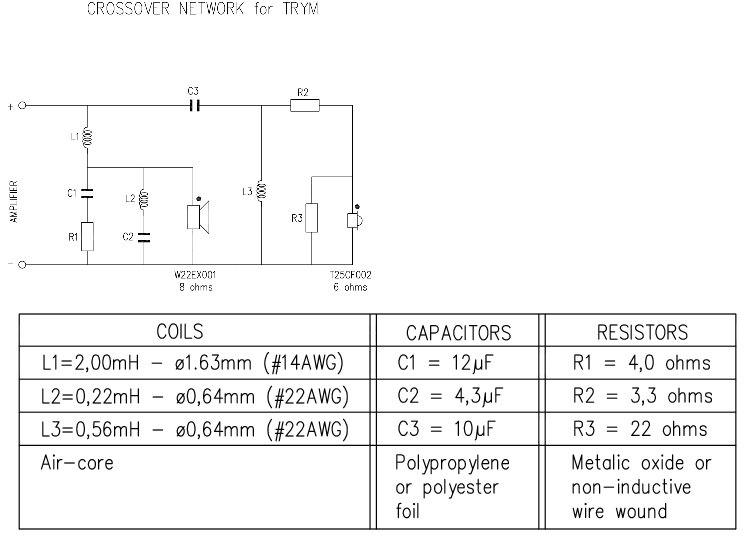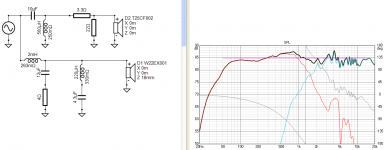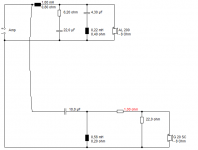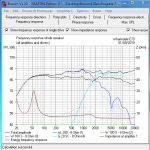I'll sim both the trym XO and the one above. I have 27tdfc (in my current 3 way) so curves should be an ok approximation.
Ok I've simmed the TRYM crossover. I assumed a 48mm offset for the W22. A bigger offset (total of 60mm) provides the best LR acoustic alignment... So either my offset guestimate is out, or the TRYM crossover could be better aligned. NB: the diagram shows only W22 Z offset 18mm because I already have 30mm loaded on the driver tab for the W22. thus a total of Z +48mm
Although accuracy of the offset plays a small part, the bigger issue with the TRYM I believe is inadequate baffle step compensation. the natural in baffle rise (as can be seen in Seas in box manufacturer measurements) is not adequately addressed with only a 2nd order 2mH inductor and 12uF cap (with a shaping resistor).
The TRYM crossover will provide a ~4dB rise from 275Hz to 900Hz. This needs to be brought down to ~ 84dB level. You can see the breakup node isn't sufficiently addressed either at 4KHz being only ~18dB from the reference level.
I can post the reverse null if interested.
I recommend a steeper filter on the W22 which addresses both (as per my original suggestion).
Although accuracy of the offset plays a small part, the bigger issue with the TRYM I believe is inadequate baffle step compensation. the natural in baffle rise (as can be seen in Seas in box manufacturer measurements) is not adequately addressed with only a 2nd order 2mH inductor and 12uF cap (with a shaping resistor).
The TRYM crossover will provide a ~4dB rise from 275Hz to 900Hz. This needs to be brought down to ~ 84dB level. You can see the breakup node isn't sufficiently addressed either at 4KHz being only ~18dB from the reference level.
I can post the reverse null if interested.
I recommend a steeper filter on the W22 which addresses both (as per my original suggestion).
Attachments
Thanks Dave for running that sim. Lot to think about over the next few weeks. Lots going on in my mind over this. May even abandon the stepped baffle. At the end of the day I will be considering everything mentioned on this thread. As a novice with regard to crossover design etc I may be biting off more than I can chew with regard to doing it myself. Lots to ponder.
Regards
Martin
Regards
Martin
G'day MArtin,
A stepped baffle is fine to use - but not really required. the difference is only 18/48mm anyway and this can be compensated for within the crossover - unlikely requiring more components (just varying values / adding a shaping resistor). This is potentially cheaper (time wise) than building stepped baffles.
Either way - whatever your preference - it can be made to work with minor adjustments.
The whole time aligned drivers on a baffle I think is overrated. maybe it fixes a problem with lobing and allowing symmetrical slopes etc... but that problem may be way down the list in terms of design priorities.
Cheers,
David.
A stepped baffle is fine to use - but not really required. the difference is only 18/48mm anyway and this can be compensated for within the crossover - unlikely requiring more components (just varying values / adding a shaping resistor). This is potentially cheaper (time wise) than building stepped baffles.
Either way - whatever your preference - it can be made to work with minor adjustments.
The whole time aligned drivers on a baffle I think is overrated. maybe it fixes a problem with lobing and allowing symmetrical slopes etc... but that problem may be way down the list in terms of design priorities.
Cheers,
David.
Speaker built
Hi Guys,
First of all I wish you all a happy new year.
Well I have built my new speakers using the Seas Trym drivers T25CF002 and Seas W22EX001. I built the crossover from the Seas supplied schematic for the kit on their site. I decided to abandon the proposed stepped baffle and waveguide options in favour of a conventional baffle with drivers recessed.
I have just spent an eternity trying to add pics to this message but I guess I'm not up to it.
Now for the adjustment phase!
Soundstage fantastic. Depth fantastic. Focus fantastic. However there is a huge problem with the base. I've tried all sorts with the damping or lack of it to sort it but to no avail. I want to stress that the bass is NOT boomy. It is tight, punchy, articulate, rhythmic etc. Just too dominant. I have noted that by raising the volume level for voice and the upper frequencies that the bass is very loud and I'm thinking of the neighbours. It seems that there is an imbalance between the two sides of the crossover.
One thing I have noticed is that when I check for the 1db attenuation I get 0.65 series and 49.17 parallel for the L Pad resistors. The crossover however asks for 3.3 for series and 22 for the parallel resistor.
I was wondering if my problem is caused by attenuation?
Any help welcome. However please don't ask for measurements as I have no means to carry such out. This is a build by ear. If I can refer you to the seas web site for the driver data sheets and the Trym crossover schematic I would be grateful. I am sorry I don't know how to post pics from my PC.
Kind Regards
Martgem
Hi Guys,
First of all I wish you all a happy new year.
Well I have built my new speakers using the Seas Trym drivers T25CF002 and Seas W22EX001. I built the crossover from the Seas supplied schematic for the kit on their site. I decided to abandon the proposed stepped baffle and waveguide options in favour of a conventional baffle with drivers recessed.
I have just spent an eternity trying to add pics to this message but I guess I'm not up to it.
Now for the adjustment phase!
Soundstage fantastic. Depth fantastic. Focus fantastic. However there is a huge problem with the base. I've tried all sorts with the damping or lack of it to sort it but to no avail. I want to stress that the bass is NOT boomy. It is tight, punchy, articulate, rhythmic etc. Just too dominant. I have noted that by raising the volume level for voice and the upper frequencies that the bass is very loud and I'm thinking of the neighbours. It seems that there is an imbalance between the two sides of the crossover.
One thing I have noticed is that when I check for the 1db attenuation I get 0.65 series and 49.17 parallel for the L Pad resistors. The crossover however asks for 3.3 for series and 22 for the parallel resistor.
I was wondering if my problem is caused by attenuation?
Any help welcome. However please don't ask for measurements as I have no means to carry such out. This is a build by ear. If I can refer you to the seas web site for the driver data sheets and the Trym crossover schematic I would be grateful. I am sorry I don't know how to post pics from my PC.
Kind Regards
Martgem
Where are you placing the speakers? What are the distances to the nearest walls?
Is the enclosure ported or sealed? if ported - what happens if you stuff the port?
Is the enclosure ported or sealed? if ported - what happens if you stuff the port?
Hi Dave,
I don’t have much lee way for adjusting placement. The speakers are 3/4 meter from tha wall. Same place as before using same 45L size cabinets which are ported to 35Hz. Have tried the bungs without any success and also tried removing the port tube which effectively tuned the cabinet to 59Hz. Nothing helped. The damping alterations produced subtle changes but didn’t improve the balance between the low and the high. Martin.
I don’t have much lee way for adjusting placement. The speakers are 3/4 meter from tha wall. Same place as before using same 45L size cabinets which are ported to 35Hz. Have tried the bungs without any success and also tried removing the port tube which effectively tuned the cabinet to 59Hz. Nothing helped. The damping alterations produced subtle changes but didn’t improve the balance between the low and the high. Martin.
My simulation changes show a change of LPAD resistors from
3.3 / 22
to
0.65 / 49
increases overall tweeter / treble response by 2.8dB from around 2.8KHz up. This should definitely be noticeable - but you may experience a bit of a dip in the 1 - 3KHz area (since the tweeter is now significantly boosted). I'd expect this 0.65/49 combination to sound a bit bright.
I'm surprised you say it's bass heavy. The Trym crossover has not a lot of bafflestep compensation by my simulation and tweeter level is appropriately attenuated to match.
What reference tracks are you listening to / using? The next step would be to play tones from a generator (e.g. using WinISD) to see where the "bloom" occurs.
3.3 / 22
to
0.65 / 49
increases overall tweeter / treble response by 2.8dB from around 2.8KHz up. This should definitely be noticeable - but you may experience a bit of a dip in the 1 - 3KHz area (since the tweeter is now significantly boosted). I'd expect this 0.65/49 combination to sound a bit bright.
I'm surprised you say it's bass heavy. The Trym crossover has not a lot of bafflestep compensation by my simulation and tweeter level is appropriately attenuated to match.
What reference tracks are you listening to / using? The next step would be to play tones from a generator (e.g. using WinISD) to see where the "bloom" occurs.
Yes Dave those L Pad values are what I get. Treble definitely not at the same level as the bass. I’ve noticed that when I set the volume for vocals the volume level is higher than with old speakers despite the fact the cabinets are the same volume using the same woofer. It’s probably not that far away. I’ll get some resistors including these and can mess around with the L pad and see how it goes.
For bass response I use Peter Gabriel shaking the tree. For image/soundstage I use Pink Floyd. Thank you Dave for your help. Martin.
For bass response I use Peter Gabriel shaking the tree. For image/soundstage I use Pink Floyd. Thank you Dave for your help. Martin.
As a point of interest I have just reverse calculated the TRYM L pad. I got the following:
Driver Impedance 8ohm
Attenuation-4.61db
Driver Impedance Difference 2.014ohm
Message : 2.01ohm - Impedance out of range.
If the above is right I’m wondering how they got there. Martin.
Driver Impedance 8ohm
Attenuation-4.61db
Driver Impedance Difference 2.014ohm
Message : 2.01ohm - Impedance out of range.
If the above is right I’m wondering how they got there. Martin.
It might be interesting to mess around with an equaliser. In time you'll get a feel for what can and can't be fixed this way, which is good information.
We seem to have an established design by SEAS here:

TRYM
45L of reflex box. Looks a bit bass heavy to me. 2mH IS a whopping bass coil. I'd better get my simulator out. We might find 1mH more to taste. But I just don't know at this stage.
Big speakers in small rooms can overwhelm at the bottom end. It's called room gain. 😕
TRYM
45L of reflex box. Looks a bit bass heavy to me. 2mH IS a whopping bass coil. I'd better get my simulator out. We might find 1mH more to taste. But I just don't know at this stage.
Big speakers in small rooms can overwhelm at the bottom end. It's called room gain. 😕
Do you have an iphone or an android phone? You could download one of the spectrum analyser apps and play some pink noise and see what you get.
If what you are used to listening to has lower than balanced bass, then if the new speakers are closer to being balanced, then they will sound bass heavy. You really do need to see measurements to know for sure.
Tony.
If what you are used to listening to has lower than balanced bass, then if the new speakers are closer to being balanced, then they will sound bass heavy. You really do need to see measurements to know for sure.
Tony.
If what you are used to listening to has lower than balanced bass, then if the new speakers are closer to being balanced, then they will sound bass heavy. You really do need to see measurements to know for sure.
This is a very good point. Commercial speakers often undercook the required bafflestep because it saves on large inductor values and higher sensitivity speakers sell.
I know you've used a W22 variant previously, but it could just be you need to get used to it.
Sweeping with some software - even if you can't accurately measure SPL (phone based mics can be wild) might show you where the anomaly is ... or not
Jesus this went of track. System 7 pointed you in the right direction. Dave Bullet's comments show a lack of understanding and is leading you down an erroneous path which will ultimately end up in a poor speaker. Don't mistake people fanatically simulating speakers as evidence of engineering capability...
It's a good point about tone controls. I usually fiddle with the tone controls of an amp to get an idea of what slight balance adjustments might be necessary on my latest build. You know, plus or minus 3dB and all that. 🙂
With my old cabinets, same dimensions and tuning and same Seas W22EX001 woofer I was generally disappointed with the bass response until I changed my system and cabling. Room gain wasn’t an issue at least until now. I’m not a fan of tone controls which is why I don’t have them.
I accept that the Seas crossover is an established design. System7 seems to see the solution as being concentrated on the woofer inductor rather than the tweeter L Pad (still can’t understand how Seas worked this) and I’m interested to see how this would change thing’s although since the inductor sets the crossover I’m guessing there would be a change required on the tweeter.
I have used music with strong bass in order to evaluate the bass response. However I have a wide musical taste.
I have to emphasise that I don’t think I’m too far away. I am so grateful to all who have been giving their time to help me in this venture.
Old man of Troon.
I accept that the Seas crossover is an established design. System7 seems to see the solution as being concentrated on the woofer inductor rather than the tweeter L Pad (still can’t understand how Seas worked this) and I’m interested to see how this would change thing’s although since the inductor sets the crossover I’m guessing there would be a change required on the tweeter.
I have used music with strong bass in order to evaluate the bass response. However I have a wide musical taste.
I have to emphasise that I don’t think I’m too far away. I am so grateful to all who have been giving their time to help me in this venture.
Old man of Troon.
With a switch to a 1mH inductor you are going to get gain in the 300Hz to 1.5KHz area increasing from 1 dB to 6Db - this will reduce bafflestep. It doesn't screw with the phase too much and you still get LR slopes with the XO point shifting up slightly. You're also increasing the playing range into the W22 breakup - so may introduce other problems. Changing a crossover as suggested really needs measurements. Swapping the inductor out will change midrange response and this may upset things about the speaker you find perfect.
All suggestions are really flying a bit blind without a combination of gated, nearfield and finally 90 degree in room sweeps to get a full picture.
The cost of buying 2 1mH inductors and shipping might be the same as buying a MiniDSP UMIK-1 and measuring and being able to see what's going on 🙂
The reason I went for LPad changes as you asked the question and these are cheaper components - and easier sourced. If they don't work - less money wasted. They also have less impact on other parts of the system.
All suggestions are really flying a bit blind without a combination of gated, nearfield and finally 90 degree in room sweeps to get a full picture.
The cost of buying 2 1mH inductors and shipping might be the same as buying a MiniDSP UMIK-1 and measuring and being able to see what's going on 🙂
The reason I went for LPad changes as you asked the question and these are cheaper components - and easier sourced. If they don't work - less money wasted. They also have less impact on other parts of the system.
Let's take it from the top.

TRYM
If a speaker seems bass heavy, you reduce the bafflestep coil. 😎
I ran this one up the flagpole in a rough and ready way with a smaller 1mH coil and did a couple of other adjustments. Looks alright to me. 😀
TRYM
If a speaker seems bass heavy, you reduce the bafflestep coil. 😎
I ran this one up the flagpole in a rough and ready way with a smaller 1mH coil and did a couple of other adjustments. Looks alright to me. 😀
Attachments
- Home
- Loudspeakers
- Multi-Way
- Crossover frequency and filter order advice sought


